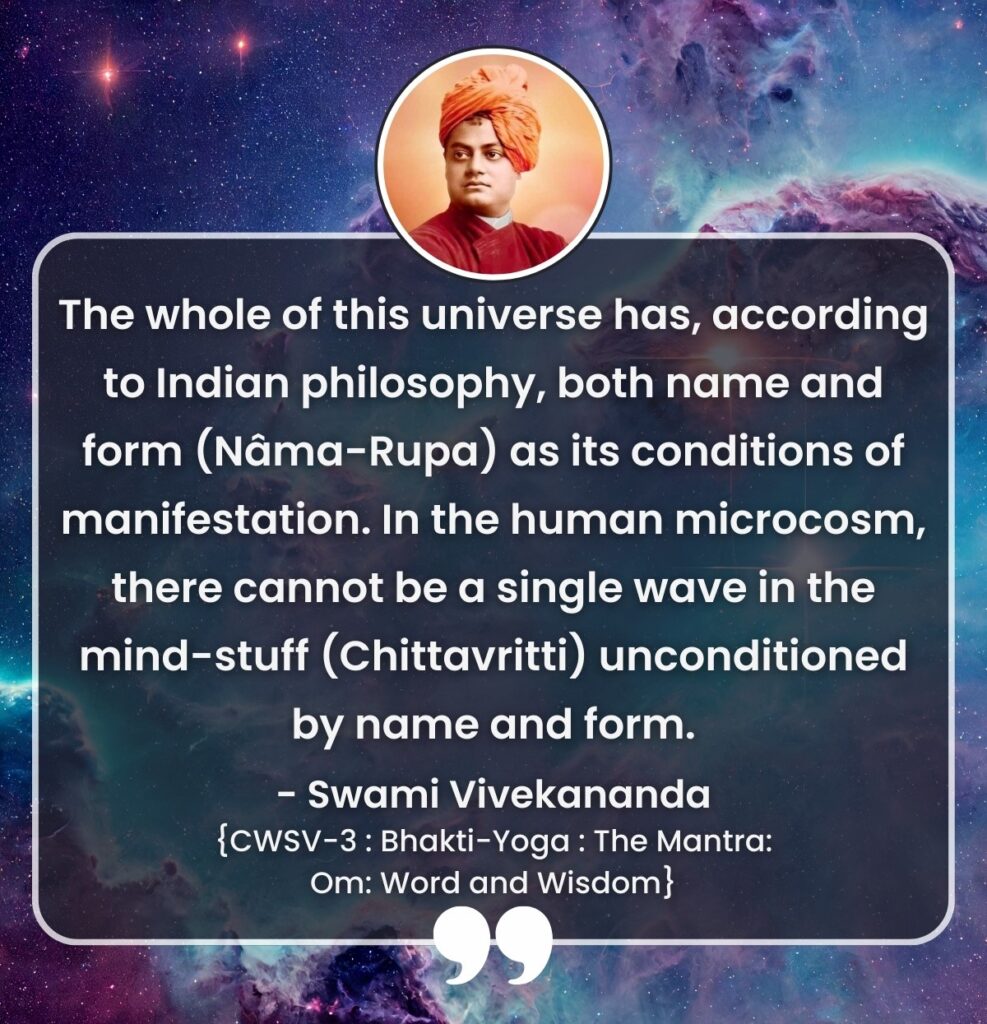But we are now considering not these Mahâ-purushas, the great Incarnations, but only the Siddha-Gurus (teachers who have attained the goal); they, as a rule, have to convey the germs of spiritual wisdom to the disciple by means of words (Mantras) to be meditated upon. What are these Mantras? The whole of this universe has, according to Indian philosophy, both name and form (Nâma-Rupa) as its conditions of manifestation. In the human microcosm, there cannot be a single wave in the mind-stuff (Chittavritti) unconditioned by name and form. If it be true that nature is built throughout on the same plan, this kind of conditioning by name and form must also be the plan of the building of the whole of the cosmos. यथा एकेन मृत्पिण्डेन सर्वं मृन्मयं विज्ञातं स्यात् — “As one lump of clay being known, all things of clay are known”, so the knowledge of the microcosm must lead to the knowledge of the macrocosm. Now form is the outer crust, of which the name or the idea is the inner essence or kernel. The body is the form, and the mind or the Antahkarana is the name, and sound-symbols are universally associated with Nâma (name) in all beings having the power of speech. In the individual man the thought-waves rising in the limited Mahat or Chitta (mind-stuff), must manifest themselves, first as words, and then as the more concrete forms.
In the universe, Brahmâ or Hiranyagarbha or the cosmic Mahat first manifested himself as name, and then as form, i.e. as this universe. All this expressed sensible universe is the form, behind which stands the eternal inexpressible Sphota, the manifester as Logos or Word. This eternal Sphota, the essential eternal material of all ideas or names is the power through which the Lord creates the universe, nay, the Lord first becomes conditioned as the Sphota, and then evolves Himself out as the yet more concrete sensible universe. This Sphota has one word as its only possible symbol, and this is the ओं (Om). And as by no possible means of analysis can we separate the word from the idea this Om and the eternal Sphota are inseparable; and therefore, it is out of this holiest of all holy words, the mother of all names and forms, the eternal Om, that the whole universe may be supposed to have been created. But it may be said that, although thought and word are inseparable, yet as there may be various word-symbols for the same thought, it is not necessary that this particular word Om should be the word representative of the thought, out of which the universe has become manifested. To this objection we reply that this Om is the only possible symbol which covers the whole ground, and there is none other like it. The Sphota is the material of all words, yet it is not any definite word in its fully formed state. That is to say, if all the peculiarities which distinguish one word from another be removed, then what remains will be the Sphota; therefore this Sphota is called the Nâda-Brahma. the Sound-Brahman.
Now, as every word-symbol, intended to express the inexpressible Sphota, will so particularise it that it will no longer be the Sphota, that symbol which particularises it the least and at the same time most approximately expresses its nature, will be the truest symbol thereof; and this is the Om, and the Om only; because these three letters अ उ म (A.U.M.), pronounced in combination as Om, may well be the generalised symbol of all possible sounds. The letter A is the least differentiated of all sounds, therefore Krishna says in the Gita अक्षराणां अकारोऽस्मि— “I am A among the letters”. Again, all articulate sounds are produced in the space within the mouth beginning with the root of the tongue and ending in the lips — the throat sound is A, and M is the last lip sound, and the U exactly represents the rolling forward of the impulse which begins at the root of the tongue till it ends in the lips. If properly pronounced, this Om will represent the whole phenomenon of sound-production, and no other word can do this; and this, therefore, is the fittest symbol of the Sphota, which is the real meaning of the Om. And as the symbol can never be separated from the thing signified, the Om and the Sphota are one. And as the Sphota, being the finer side of the manifested universe, is nearer to God and is indeed that first manifestation of divine wisdom this Om is truly symbolic of God. Again, just as the “One only” Brahman, the Akhanda-Sachchidânanda, the undivided Existence-Knowledge-Bliss, can be conceived by imperfect human souls only from particular standpoints and associated with particular qualities, so this universe, His body, has also to be thought of along the line of the thinker’s mind.
This direction of the worshipper’s mind is guided by its prevailing elements or Tattvas. The result is that the same God will be seen in various manifestations as the possessor of various predominant qualities, and the same universe will appear as full of manifold forms. Even as in the case of the least differentiated and the most universal symbol Om, thought and sound-symbol are seen to be inseparably associated with each other, so also this law of their inseparable association applies to the many differentiated views of God and the universe: each of them therefore must have a particular word-symbol to express it. These word-symbols, evolved out of the deepest spiritual perception of sages, symbolise and express, as nearly as possible the particular view of God and the universe they stand for. And as the Om represents the Akhanda, the undifferentiated Brahman, the others represent the Khanda or the differentiated views of the same Being; and they are all helpful to divine meditation and the acquisition of true knowledge.

